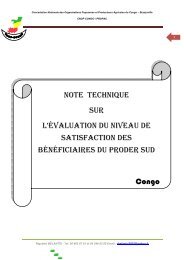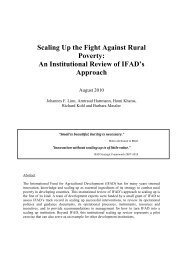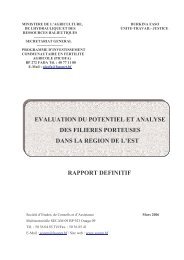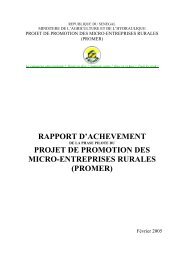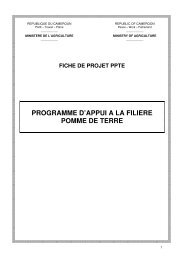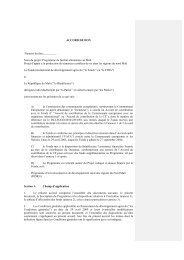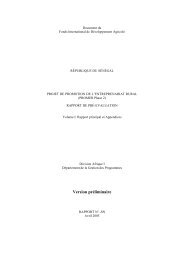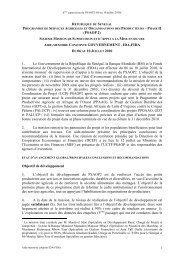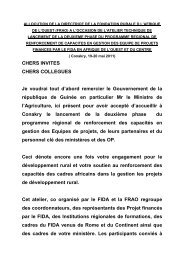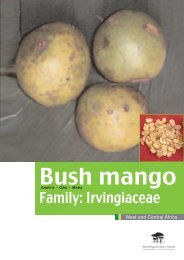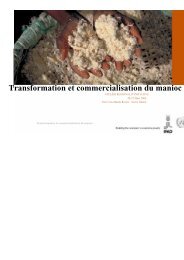CASSAVA OPPORTUNTIES IN NIGERIA - FAO.org
CASSAVA OPPORTUNTIES IN NIGERIA - FAO.org
CASSAVA OPPORTUNTIES IN NIGERIA - FAO.org
Create successful ePaper yourself
Turn your PDF publications into a flip-book with our unique Google optimized e-Paper software.
Such calculations are used on a daily if not hourly<br />
basis to determine the appropriate mix of inputs<br />
for commercial operators.<br />
It has been said that the price of cassava must<br />
represent 80 percent of the price of maize for it to<br />
be competitive. Other benchmark prices may also<br />
exist but using this one, Figure 4-5 illustrates<br />
those states where cassava is competitive and<br />
those where it is not.<br />
Figure 4-5 Cassava-Maize Price Ratio and Cassava<br />
Production<br />
The dots in this figure represent the cassava price<br />
ratio to maize. The horizontal line represents the<br />
80 percent benchmark. Those states whose dot is<br />
above the line are said to be uncompetitive at the<br />
time of review (using 2000 prices) and those<br />
states whose dot is below the line are said to be<br />
competitive. Coupled with the level of cassava<br />
production in each state (the bars) one can<br />
quickly see those states that have an advantage<br />
in cassava production, processing and utilization.<br />
Cross river, Rivers, Enugu, Imo, Kogi and Kaduna<br />
all appear to be strong contenders barring other<br />
considerations such as resources in land, labour,<br />
water, etc.<br />
4.2 FUTURE TARGETS<br />
There are two future price and margin targets for<br />
Nigeria to strive for. The first is a short-term target<br />
that lowers domestic costs of production and final<br />
prices to remain competitive against internal<br />
competition. The second, a long-term target, that<br />
lowers the costs of production and final prices to<br />
attain international competitiveness.<br />
21<br />
In the case of the first target, it is the impression<br />
that cassava has only been used by industry<br />
when maize or wheat prices were high. Potential<br />
users of cassava do not generally talk of using<br />
cassava because the price is low. There is a need<br />
to achieve lower cassava prices so that cassava<br />
is used because its price is competitive.<br />
In most instances the competitive price for<br />
cassava is the price of imported replaceable<br />
commodities. The primary candidates for<br />
replacement are maize, wheat flour, ethanol and<br />
starch. It is assumed that cassava chips or pellets<br />
could be competitive with maize and it is also<br />
assumed that cassava chips would be produced<br />
in the Thai manner with a 1 to 2.5 ratio of chips to<br />
roots. The conversion factor in this table also<br />
includes the aforementioned 80 percent factor<br />
(3.125=2.5/.80). Cassava flour is assumed to be<br />
the prime commodity to compete with imported<br />
wheat and wheat flour in the bakery, confectionary<br />
and flour milling industries. Fresh cassava is<br />
assumed to be the primary input for the<br />
production of ethanol. Finally, cassava starch<br />
could compete with imported starches.<br />
The following table indicates the range of these<br />
prices (high and low) and converts them to a naira<br />
value (the last column of the table). This value<br />
provides an indication of the target price (roots<br />
plus processing) that would make cassava and<br />
cassava products competitive.<br />
For example, it would appear that cassava chips<br />
or pellets could be competitive with maize if the<br />
cost of cassava roots and processing was in the<br />
range of N6 550 to N12 254. Obviously when<br />
maize prices are low the cost of roots and<br />
processing has to be at the lower price range.<br />
For cassava to be competitive in the ethanol and<br />
starch industries, the cost of cassava roots and<br />
processing should be in the range of N11 213 and<br />
N18 860.<br />
When attempting to identify the relative<br />
importance of these target prices it should be<br />
recalled that the cost of processing cassava<br />
differs greatly between the industries. Ethanol<br />
processing is probably the highest cost industry<br />
followed by starch – at least the production of high<br />
quality modified starch.



